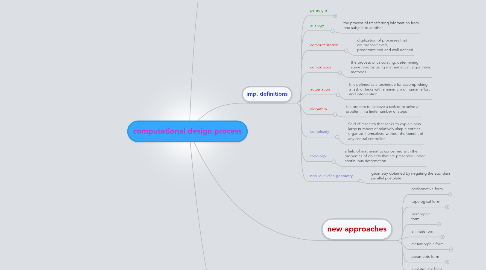
1. systems
1.1. fractals
1.1.1. A fractal is a geometric object generated by a repeating pattern, in a typically recursive or iterative process.
1.2. L- systems
1.2.1. parrallel re-writing system, known for modeling growth processes of plant developement
1.3. cellular automata
1.3.1. a grid of cells with infinite number of states, each cell is affected by its neighboring cells
1.4. voronoi
1.4.1. The partitioning of a plane with points into convex polygons such that each polygon contains exactly one generating point and every point in a given polygon is closer to its generating point than to any other
1.5. fibonacci
1.5.1. a sequence of numbers defined by the equation Xn= X(n-1) + X(n-2)
1.6. catenary
1.6.1. the curve that an idealized hanging chain or cable assumes under its own weight when supported only at its ends.
1.7. cadenary
1.7.1. a software developed by Axel Killian to simulate catenary structures using particle systems
2. new approaches
2.1. performative form
2.1.1. characteristics
2.1.1.1. using building performance as a guiding design principle
2.1.1.2. utilizes digital tools of qualitative and quantitive based simulation to offer a more comprehensive approache to design
2.1.2. pioneers
2.1.2.1. norman foster
2.1.3. projects
2.1.3.1. london city hall
2.2. topological form
2.2.1. characteristics
2.2.1.1. departure from eclidian geometry
2.2.1.2. extensive use of topologican (rubber sheet) and NURBS curves and surfaces
2.2.2. pioneers
2.2.2.1. Gryg Lynn
2.2.3. projects
2.2.3.1. Bilbao
2.3. isomorphic form
2.3.1. characteristics
2.3.1.1. departure from eclidian geometry
2.3.1.2. the use of blobs, Metaballs
2.3.1.3. parametric objects with internal forces of mass and attraction
2.3.1.4. objects have fields of influence wich could be additive or subtractive
2.3.2. pioneers
2.3.2.1. Greg Lynn
2.3.3. projects
2.3.3.1. BMW pavillion
2.4. animate form
2.4.1. characteristics
2.4.1.1. utilizes animation software as a means of form generation in stead of representaional tools
2.4.1.2. uses
2.4.1.2.1. keyframw animations
2.4.1.2.2. inverse kinematics
2.4.1.2.3. dynamics
2.4.1.2.4. particle emissions
2.4.2. pioneers
2.4.2.1. Greg Lynn
2.4.3. projects
2.4.3.1. beachness hotel- NOX
2.5. metamorphic form
2.5.1. characteristics
2.5.1.1. uses techniques like
2.5.1.1.1. keyshape animation
2.5.1.1.2. abstract deformation on lattice
2.5.1.1.3. path animations
2.5.1.2. changes in the geometry are recorded as key frames and the software computes the inbetween states of the form
2.5.2. pioneers
2.5.2.1. Peter Eisenman
2.5.3. projects
2.6. parametric form
2.6.1. characteristics
2.6.1.1. the parameters of a design are declared, not its shape
2.6.1.2. equations are used to describe the relationship between objects
2.6.1.3. algorithmic discribtion of geometrty and physical environment
2.6.2. projects
2.6.3. pioneers
2.7. evolutionary form
2.7.1. characteristics
2.7.1.1. proposes the evolutionary model of nature as the generating process of form
2.7.1.2. architectural concepts are expressed as generative rules, development tested using the computer
2.7.1.3. computer models are used to simulate the development of prototypes wich are tested for performance
2.7.2. projects
2.7.3. pioneers
3. imp. definitions
3.1. paradigm
3.1.1. A set of assumptions, concepts, values, and practices that constitutes a way of viewing reality for the community that shares them
3.2. analogy
3.2.1. the process of transferring information from one subject to another
3.3. computerization
3.3.1. digitization of processes that are preconcieved, predetermined and well defined
3.4. computation
3.4.1. the process of calculating, determining something by using mathematical, algorithmic methods
3.5. automation
3.5.1. It is defined as a technique for accomplishing a task or tasks with a minimum of human effort and intervention.
3.6. algorithm
3.6.1. is a process to achieve a task or to solve a problem in a finite number of steps
3.7. complexity
3.7.1. field of research that seeks to explain how large numbers of relatively simple entities organize themselves, without the benefit of any central controller
3.8. topology
3.8.1. a field of mathematics concerned with the properties of objects that are preserved under continuous deformation
3.9. non- euclidian geometry
3.9.1. geometry obtained by negating the euclidian parallel postulate
4. form follows technology
4.1. digital tools in exile
4.1.1. architects
4.1.1.1. Frank O Gehry
4.1.1.1.1. using digitizers in later design phazes
4.1.2. characteristics
4.1.2.1. utilization of technology in architecture
4.1.2.2. the computer is not a partner but a tool
4.1.3. projects
4.1.3.1. olympic fish
4.1.3.2. bilboa museum
4.2. digital tools in control
4.2.1. characteristics
4.2.1.1. relying on film industry software
4.2.1.2. imposing dynamic forces of the context on preliminary shape
4.2.2. Architects
4.2.2.1. Gref Lynn
4.2.3. projects
4.2.3.1. embryplogical house- Greg Lynn
4.2.3.2. BMW pavillion- Bernard Frankin
4.3. moderate approach
4.3.1. characteristics
4.3.1.1. mid ground of the former approaches
4.3.1.2. bussines and financial aspects play major role
4.3.1.3. computer role: provide the environmint within which project constraints are recorded
4.3.2. architects
4.3.2.1. Foster+ Partners
4.3.2.2. shop architects
4.3.3. projects
4.3.3.1. city hall london- Foster
4.3.3.2. the fashion institute of technology- shop architects
4.4. industrial design approch
4.4.1. characteristics
4.4.1.1. integeration of mass production and customization in the design and manifacturing approach adopted by industrial design
4.4.1.2. technology is integerated holisticaly
4.4.2. architects
4.4.3. projects
